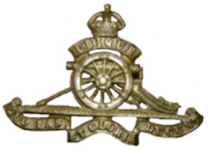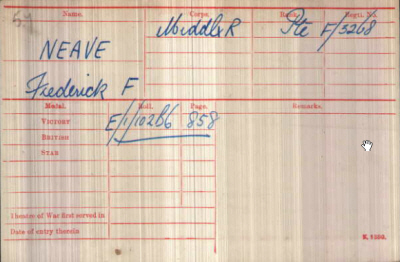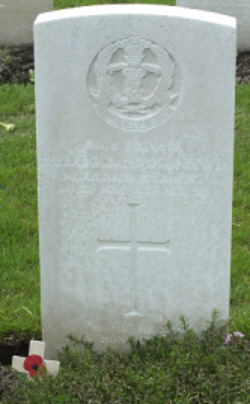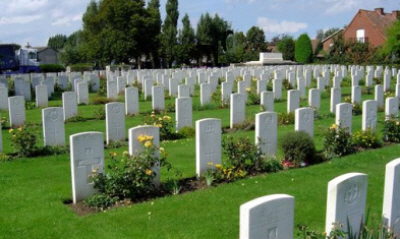



3268, Private, Frederick Frank NEAVE
Aged 25

Duke of Cambridge's Own (Middlesex Regiment), 23rd (2nd Footballers) Battalion
Killed in Action on Sunday 20th May 1917
|
Born in Barnsbury N London (Islington Q2-1892 1B:321)
1901 census... Aged 8, he was living at 39 St James Road, Islington with his father- Frederick NEAVE [35] postmaster born Clerkenwell; mother- Minnie Phipp (née ROLPH) [30] born Lakenheath; sister- Gladys May[2] born Barnsbury and boarder William E ROLPH [24] born Lakenheath ( Uncle?). 1911 census... Aged 18, a commercial traveller Millinery, living at 72 Sydney Road, Hornsey with his parents and sister Gladys and Eliza ROLPH. It appears his only Lakenheath connection was through his mother's family. The penson card has his mother at 7 Burghleigh Road, Hornsey N8 |

|
Enlisted in Mill Hill, lived in Hornsey,Middlesex. He enlisted on 12th January 1916, giving his age as 26 yrs 2 months, 5'10" (177.8 cm)tall, chest 37 1/2 to 40" (95.3 to 101.6). He gave his occupation as warehouseman and father as next of kin, living at Burghley Road, Hornsey. For some reason he seems to have added 2 years to his age Mobilised on 13th February 1916, he was admonished for overstaying a leave pass by 21 hours on 17th July 1916. Sent to France in the BEF on 15th August 1916, he was posted to the 23rd Battalion, Middlesex Regiment on 31st August 1916, and was killed in action on 20th May 1917. He apparently suffered from bouts of bronchitis, even before going to France. One qualification on his records is "cold shoer" ?. His father received his personal effects on 3rd May 1918 which consisted of note book, card case, cigarette case, photos, wristwatch, broken compass and pocket knife. The 23rd Middlesex arrived on the Western Front in May 1916 and went into the line near Le Touquet. In August 1916 the Battalion moved south to the Somme, where it participated in the attack at Flers (the first occasion on which tanks appeared on the battlefield), suffering heavy casualties. At the time of Fredericks death they seem to have been in support snce he was the sole battalion death that day. On 7 June 1917 the 23rd Middlesex were involved in the attack at Messines, a few miles south of Ypres. Four days later, when the Battalion left the front line, only eight officers and 298 other ranks had not become casualties. The Bury Free Press of 2nd June 1917:- ANOTHER LAKENHEATH HERO KILLED IN ACTION The sorrowful news was received by Mrs Tipple, High Street, on Saturday morning that her grandson, Fred Neve (sic), had been killed in battle in France. He was the only son of Mr & Mrs F.Neve, Hornsey,London, and was 23 years of age. At Lakenheath and in the district he was well known. A claim to fame for the 23rd Middlesex was the commissioning of Walter Tull, the first coloured officer in the Britsh Army. He was a player for Leyton Orient and it caused quite a stir when he was commissioned in May 1917. So far unable to find if Frederick Neave was any sort of footballer. The story of the "Footballers Battalions" from http://www.kickitout.org/files/af057e9a-/Footballers%5C'%20Battalion%20Memorial%20v4.pdf Following the outbreak of war in August 1914, a heated debate took place in the letter pages of national and local newspapers about the continuance of professional football during a time of national crisis. Several prominent personalities of the day, such as W.G. Grace and FM Roberts saw fit to pass comment. The issue was also raised in the House of Commons. Such was the strength of feeling that it was even suggested to King George V that he should withdraw his patronage of the Football Association. Professional players in particular were vilified by large sections of the press as unpatriotic shirkers who put their own interests before those of their country. The row grew increasingly vitriolic, and in late November 1914 the FA and FM Kitchener realised that something had to be done. The following month, the Rt. Hon Joynson Hicks raised the Footballers� Battalion (17th Middlesex) at a meeting in Fulham Town Hall with some 35 professional footballers enlisting straight away. As an incentive, new recruits were promised that they would be released from the army to play every Saturday for their respective clubs. Over the next few months, another 300 or so professional players enlisted from around fifty football clubs, including West Ham, Chelsea, Liverpool, Leyton Orient, Plymouth Argyle and Reading. The ranks of the 17th Middlesex were further swelled by numerous amateur players, officials and football fans eager to serve alongside their favourite players. Special recruiting posters were displayed at grounds of London clubs, specifically aimed at the home supporters . A Millwall supporter would thus find himself being exhorted to �Let the enemy hear the �Lion�s Roar��. In May 1915 a second Footballers� Battalion (23rd Middlesex) was set up. Both Battalions would be involved in fierce fighting over the coming years. By the time the war ended in November 1918, over one and a half thousand men, who had served with the Footballers� Battalions at some stage of the Great War, had lost their lives. |



© Pierre Vandervelden www.inmemories.com
click here to go to the Commonwealth War Graves
Commission website for full cemetery/memorial details